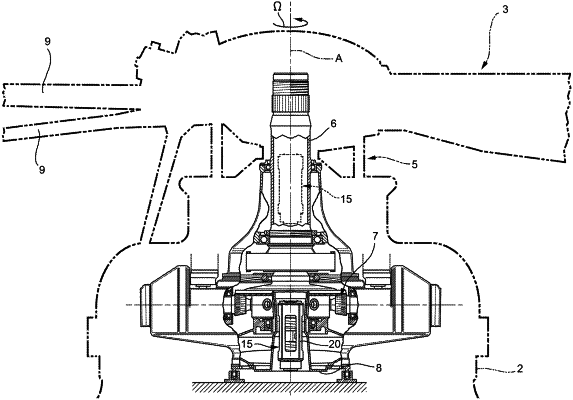| CPC B64C 27/001 (2013.01) [B64C 27/06 (2013.01); B64C 27/46 (2013.01); B64C 2027/003 (2013.01); B64C 2027/004 (2013.01); B64C 2027/005 (2013.01)] | 15 Claims |

|
15. A rotor (3) for a hover-capable aircraft (1), comprising:
a hub (5) rotating about an axis (A) and, in turn, comprising a plurality of blades (9);
a mast (6) connectable to a power unit of said aircraft (1) and operatively connected to said hub (5) to drive said hub (5) in rotation about said axis (A); and
an attenuating device (15) to attenuate the transmission of vibrations from said mast (6) to said aircraft (1) parallel to said axis (A);
said attenuating device (15), in turn, comprising:
a casing (20);
a first mass (21) free to oscillate parallel to said axis (A) with respect to said casing (20) and elastically connected to said casing (20);
characterized in that said attenuating device (15) is passive and further comprises:
a second mass (25);
connection means (30) adapted to make said first and second masses (21, 25) integrally movable along said axis (A) when an angular speed (Ω) of said mast (6) assumes a first value (Ω1); and
actuator means (35) activatable to decouple and separate said first and second masses (21, 25) with respect to translation along said axis (A) when said angular speed (Ω) of said mast (6) assumes a second value (Ω2), different from said first value (Ω1);
wherein said attenuating device (15) further comprises:
at least one spring (23) interposed between said casing (21) and said first mass (21); and
an anti-rotation device (45) interposed between said at least one spring (23) and said first mass (21), and adapted to prevent the rotation of said first mass (21) about said axis (A); and
wherein said attenuating device (15) further comprises:
a first end of travel device (40) and a second end of travel device (41) adapted to respectively limit the travel of said first mass (21) and of said second mass (25) integral with one another when the angular speed (S2) of said mast (6) assumes, in use, said first value (Ω1);
said first end of travel device (40) being arranged in abutment against said second mass (25) axially spaced apart from said first mass (21) when the angular speed (Ω) of said mast (6) assumes, in use, said second value (Ω2);
said first and second end of travel devices (40, 41) being stationary with respect to said casing (20) and being arranged at respective opposite sides of said first and second masses (21, 25); said anti-rotation device (45) being further adapted to prevent the rotation of said second mass (25) about said axis (A).
|